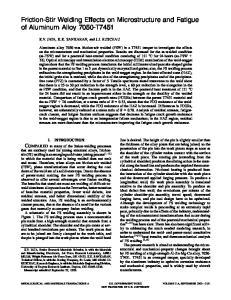Experimental Research on Fatigue Failure for 2219-T6 Aluminum Alloy Friction Stir-Welded Joints
- PDF / 2,113,729 Bytes
- 8 Pages / 593.972 x 792 pts Page_size
- 36 Downloads / 359 Views
JMEPEG DOI: 10.1007/s11665-017-2836-y
Experimental Research on Fatigue Failure for 2219-T6 Aluminum Alloy Friction Stir-Welded Joints Guo-Qin Sun, Jiang-Pei Niu, Ya-Jing Chen, Feng-Yang Sun, De-Guang Shang, and Shu-Jun Chen (Submitted February 15, 2017; in revised form May 19, 2017) The fatigue experiment was executed for the 2219-T6 aluminum alloy friction stir-welded joints at the rotation speed of 800 r/min and the welding velocity of 150 mm/min. Most fatigue failures occurred in the weld nugget zone (WNZ), the thermo-mechanical affected zone and the nearby areas. The experimental results demonstrated that the sudden hardness gradient increases sites corresponding to the fatigue failure locations. The high-angle grain boundaries with the highest concentration were scattered within the WNZ. The microcracks initiated at the intersection of the soft grains. More than one crack initiation site was observed within the WNZ and the thermo-mechanical affected zone, when the fracture occurred in these areas. The rough surface of the welding area should be one of the main reasons for the fatigue failure occurrence. The fatigue crack growth rate in the WNZ at the first stage was fastest in comparison with the fatigue crack growth rate in the other areas of the joint. Keywords
crack growth, fatigue failure, friction stir welding, hardness gradient, microstructure
1. Introduction The friction stir welding (FSW) is a solid-state joining technique, which was invented by The Welding Institute (TWI) in 1991. Currently, the FSW technology has been applied in aerospace and automotive applications, railway vehicles, ships and other industrial fields, due to the corresponding good welding quality compared to the traditional fusion welding technology (Ref 1-5). It has been utilized to weld various important aluminum alloys, such as the high strength aluminum alloys (2xxx, 6xxx and 7xxx series). The AA2219 is a precipitation hardening Al-Cu alloy and displays excellent mechanical properties, which has been utilized in certain structural components that sustained loading. The welding constitutes the primary joining method, and the fracture is the main failure mode for the welded structures. Several investigations were conducted on the microstructural evolution and mechanical properties of the AA2219 alloy FSW joints (Ref 6-10). The weakening mechanism and the tensile fracture behavior of the AA 2219 friction plug weld were investigated (Ref 11). Malarvizhi (Ref 12) investigated the fatigue crack growth behavior of friction stir-welded joints of AA 2219 alloys. The results demonstrated that the FSW joints exhibited an improved fatigue crack growth resistance compared to both gas tungsten arc- and electron beam-welded joints.
Guo-Qin Sun, Ya-Jing Chen, Feng-Yang Sun, De-Guang Shang, and Shu-Jun Chen, College of Mechanical Engineering and Applied Electronics Technology, Beijing University of Technology, Beijing, China; and Jiang-Pei Niu, CRRC Tangshan Co., Ltd., Tangshan, China. Contact e-mail: [email protected].
Journal of Materials En
Data Loading...











